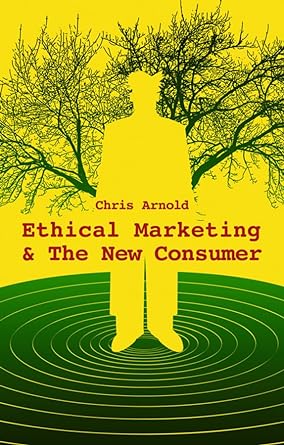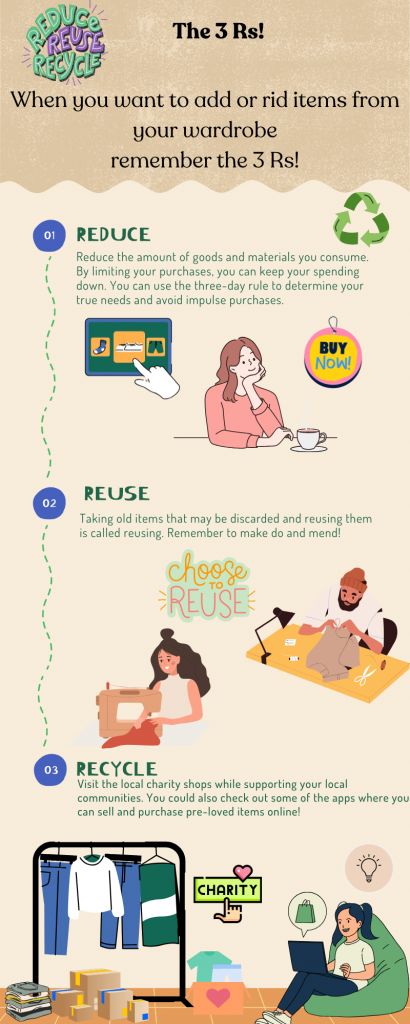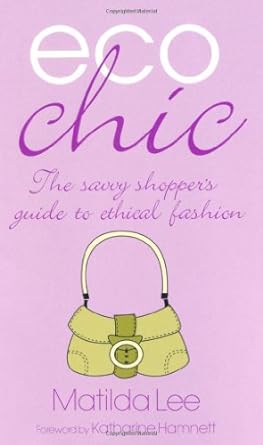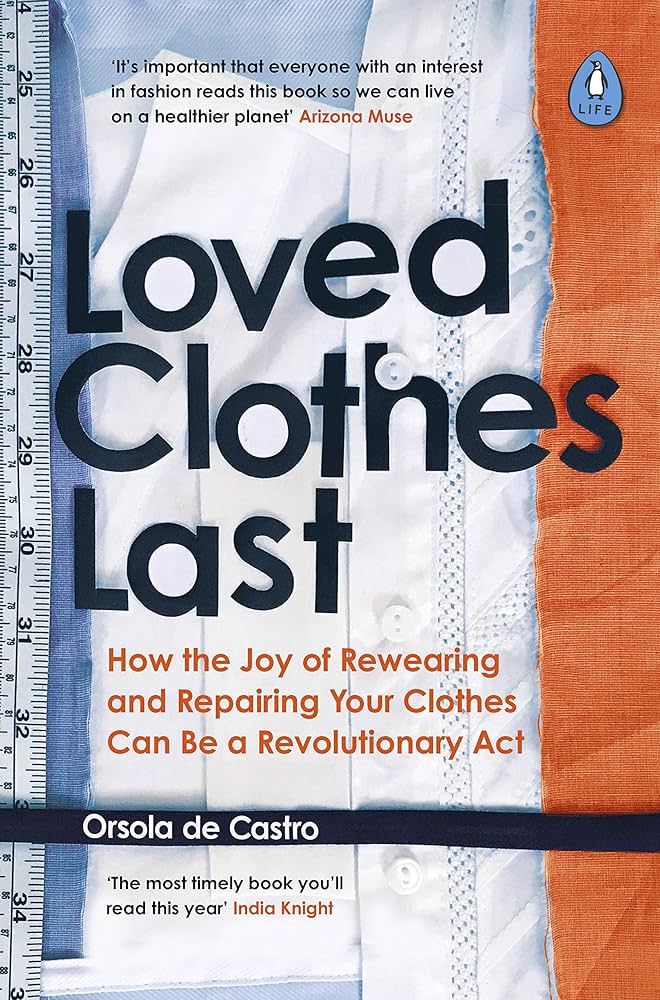The fashion industry and fast fashion
Fast fashion has taken the industry by storm in recent years. Since the COVID-19 outbreak and the credit crunch there has been a high demand by consumers to have items of clothing available to them faster than ever but also at low cost, which comes with many disadvantages to the environment, other countries and factory workers who manufacture these brands. The need for fast fashion is not set to decline any time soon!
So, what is wrong with low-cost clothing?
Currently the fashion industry has seen an increase in brands such as Primark and Shein. These brands typically manufacture garments quickly and cheaply to due to the fact that the clothes are not made to last. This kind of fashion manufacturer is known as a ‘Fast Fashion Brand’. Fashion is created, sold and disposed of, using a fast process!
“Fast fashion has taken the industry by storm due to its cheap methods and the
increase in consumer appetite for rapidly evolving trends” Bernard (2013)
Reflected in the book, ‘Ethical marketing and the new consumer’, Arthur quotes Primark,
as:
“Providing credit crunched consumers with clothes so disposable they’re not worth
washing” Arnold (2009)
Arnold discusses the clothing created by these brands as created so cheaply they’re not
worth washing as they will just fall apart! But the fashion brand will already be aware of
this as they will go on to market a new item of clothing the following week. This kind of
fashion manufacturing is known as a ‘Fast fashion Brand.

Primark back in 2009 dominated the high streets but did you know what this meant for
the environment?
“Our cheap fashion thrills are causing a major landfill problem” Arnold states that, “74%
of clothes bought are thrown away and those 7.5 billion items of clothing are going into
our bins annually in the UK” Arnold (2009)
Image Licensed by Adobe stock Education License created by Halfpoint
Arnold goes on to say this is;
“accounting up to 30% of all waste sent to landfill” Arnold (2009)
To add to these figures, the government also added the amount of direct marketing
used regarding promotion of these garments, adding to “2% of household waste!
If you would like to find out more you can locate the book by Arnold which is
discoverable via LibrarySearch as an e-book or physical book edition.
Financial constraints when buying from a fast fashion brand.
Fast fashion is cheap but not manufactured with the intention of garments made to last. So even though the initial cost of the item is minimal, the item won’t last and may only be able to be worn once. There would be a need to purchase another item and so the cycle begins!
Make, Use, Dispose
Trends and marketing of fast fashion items.
Let’s take another fashion brand, for example Shein. Shein is a well-known online fast fashion brand which sells millions! In some articles the brand has been quoted as the Ultra-fast fashion brand.
Ethical Consumer reports:
“last two years have brought us the spectre of ‘ultra-fast fashion’ with new online brands like Shein adding upwards of 6,000 new clothing designs to their website each day” Ethical Consumer (2024)

Image Licensed by Adobe stock Education License created by Halfpoint
This brand uses Tik Tok to sell fashion fast by marketing an item of clothing for one week then changing to another product the following week! People who use Tik Tok are the brand’s largest consumer. Findings have shown that Gen-Z are the biggest consumers with a massive 49% of 18–23-year-olds are shopping online more than once a week. Just over 28% of 24–30-year-olds, known as millennials, are also doing the same, shopping for items at least once a week. Bernard (2023)
As we’re aware, social media preys on insecurities and pressures by targeting consumers virtually anywhere and this can be constant for Gen-Z who spend a lot of time online as they’re the projected market audience. The result of this quick use of marketing means a constant turnover of stock, which is not all successfully purchased. It has been reported that items that are not sold within this week are burnt or sent away to other countries and left as waste. This can also include materials wasted during the manufacturing stage and adds to the environmental crisis.
What are the implications of buying clothes from these outlets?
Environmental implications
Many countries, including the United States, transfer its environmental waste to other countries and add to their humanitarian problems. In the article ‘The Hidden Costs Behind Cheap Clothing: Addressing Fast Fashion’s Environmental and Humanitarian Impact’, the author, Bernard suggests:
“Because many fast fashion garments are unable to be reused or resold in thrift stores domestically due to their poor quality, these items are shipped overseas to developing countries”
Bernard, goes on to discuss the amount of waste sent from the United States (2023)
“Almost fifteen million used clothing items arrive in Ghana each week. Meanwhile, the United States exports more secondhand clothing than any other country,”
While some may see this as a charitable gesture it means that:
“In Ghana, 40 per cent of the clothing bales received from Western countries end up in landfills, causing local officials to call for the United States to stop hiding under the guise of donations of secondhand clothing”
Bernard (2023)
What is worrying is back in 2020 a stock of clothes outside of Ghana’s capital generated so much methane that it exploded and continued to burn for months. This would have resulted in mass emissions of toxic polluting gases.
The European Union Commission reported that:
“Worldwide, a full truck of textiles is sent to incineration or landfilled every second. It is estimated that less than 1% of all textiles worldwide are recycled into new textiles”.
European Union Commission (2020)
The EU has created a ‘2030 Vision for Textiles’ strategy which would drive new business models by asking brands to change from Make, Use and Dispose to Reduce, Reuse and Recycle.
They want to create processes for sorting, reusing and recycling textiles. Clothes will be created to last longer not as throw away garments.
“Moving from fast fashion to timeless fashion”
European Union Commission (2023)
Social implications
Countries tend to send textiles to other developing countries and thus transfer the environmental and humanitarian issues to them.
Asian countries are the main hub for textiles manufacturers with forty million people working within the sector. Textile workers are often kept away from contracts of employment and not aware of any legal rights or laws to protect them from exploitation.
Many workers earn less than the living wage, so they are unable to feed themselves, let alone their families. They cannot finance healthcare, education, or other amenities. They can work long hours with little break entitlement and there’s a lack of health and safety legislation, with no access to PPE (Personal Protective Equipment).
Fairtrade international is just one of the organisations that invest time in working with manufacturers to make sure workers are being protected from exploitation but there is still much work to do.
“Fast fashion takes a heavy toll on the people who make the world’s clothes. By choosing garments produced under Fairtrade conditions, you can support workers to make a decent living, stand up for their rights, be safe, and get enough sleep – who wouldn’t want that for themselves or others?”
Fairtrade International (2024)

Image found from Pixabay free image license.
Eco-Hope
What can we do?
Hopefully this post will give you an insight into what is happening worldwide regarding the issues surrounding fast fashion. But we could all do something if we’re just aware of what is happening within the fashion industry!
“The best way to make a contribution in fashion is to promote the idea that a fundamental interest in preserving the environment is itself fashionable” (Giorgio Armani)
It isn’t all bad, to quote Bob Dylan, ‘The Times they are a changin’
Ethical Consumer quotes,
“A boom in secondhand clothing sales”
Ethical Consumer (2024)
In 2023 ethical markets reported a 49% rise from last year in the amount spent on pre-loved clothes. Second hand clothes have seen an increase in sales, whilst other surveys have reported the same!
“GlobalData’s figures report “the clothes resale market in the UK grew by 149% between 2016 and 2022”
Ethical Consumer (2024)
The article goes on to suggest that this figure will only increase,
“would grow by a further 67% between 2022 to 2026”
Secondhand fashion is even hitting the runway, opening London’s fashion week with a exhibition of pre-loved clothing organised by Oxfam.
When you want to edit your wardrobe or add some items! Remember the 3Rs!
Click on the infographic for tips!
Infographic created by V Mason using Canva.
I think if we worked together to find alternatives instead of choosing fast fashion, we could all make a difference! All it takes are small steps – let’s look at what we can do…
Secondhand clothing.
Worth the weight – vintage kilo sales.

Worth the Weight Vintage Kilo Sale website.
This is across Kent; there are events happening in Canterbury where you can bag a kilo of clothes for just £20. To find out more about events coming up check out the website https://www.westgatehall.org/event/worth-the-weight-vintage-kilo-sale-5/all/
Vinted – this has become a very popular app where you can sell and buy items. More money in your pocket plus you’re helping the environment! https://www.vinted.co.uk/
Charity shops – you can get some lovely clothes in the local charity shops. Check out the high streets for some bargains!
Make do and mend
Recycling your clothes to create other useful items? Check out Bob’s blog post all about ‘Stitching and not ditching’ available here:
Canterbury Repair Cafe
Did you know we have a repair cafe right here in Canterbury? It’s located in St George’s Place. You can find out more by following Canterbury Repair Cafe on Facebook!
Sustainability collection
Check out the Sustainability Collection in Augustine House Library. Books can be loaned for 4 weeks! You can find some inspiration for more ideas on how to support the environment with little changes!
Check out the Eco-hope display currently on the 2nd floor during March. Photo taken by UE Team.
Image created by V Mason using Adobe Express and photos taken by V Mason.
Sustainability events across the university
Several sustainability events across Canterbury Christ Church University. Events take place throughout the year in collaboration with the university’s wider communities.
To find out more check out the Canterbury Christ Church University Sustainability page!
StressLess
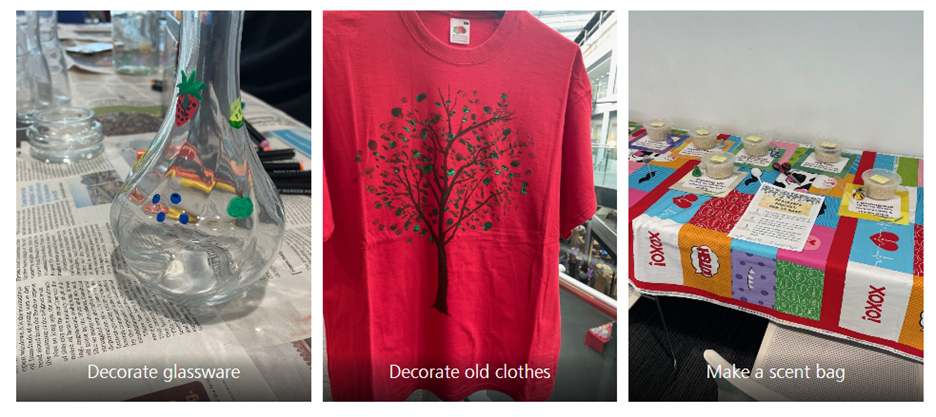
All Curriculum Resource photography by Jason Shirley – Library and Learning Resources.
Check out the StressLess events happening at Augustine House and find some Eco-Hope inspiration from Steve’s blog: Inspiring eco-hope with StressLess throughout March.
Join in four weekly Eco Hope themed StressLess events with a variety of fun activities available from green crafts like upcycling, to making positive change by signing petitions and emailing your MP.
Click here for StressLess Eco Hope events
Useful websites for more information.
Please do have a look at the good work charities and organisations are doing to support factory workers within the fashion industries.
Created by V Mason in Adobe Express 2023.
Further reading in the library
Eco chic: the savvy shopper’s guide to ethical fashion by Matilda Lee.
Loved clothes last by Orsola de Castro available as an e-book also a print edition has just been added to the Sustainability collection.
Both titles are avaialble via LibrarySearch
Thank you for reading!
I hope if anything it creates awareness regarding environmental and humanitarian issues surrounding Fast fashion. Let’s join the slow fashion movement!
I will just leave you with these wise words from the inspirational Vivienne Westwood.
“Buy less, Choose Well, Make it last”
References (All discoverable via LibrarySearch and online)
Articles
Gleason-Allured, J. (2019) ‘The future is pre-loved’, Global cosmetic industry, pp. 6.
Books
Arnold, C. (2009) Ethical marketing and the new consumer. Chichester: Wiley.
Castro, Orsola de. (2021) Loved clothes last how the joy of rewearing and repairing clothes can be a revolutionary act. London: Penguin Life.
E-books
Arnold, C. (2009) Ethical marketing and the new consumer. Chichester: Wiley.
Journal articles
Bernard, A.L. (2023) ‘The hidden costs behind cheap clothing’, Vanderbilt Journal of Entertainment and Technology Law, Issue information 25(541), pp. 541- 567.
Ronda,L. (2024) ‘Overcoming barriers for sustainable fashion:bridging attitude-behaviour gap in retail’, International Journal of retail and distribution management, 52(1), pp. 44-61.
Teibel, E. (2019) ‘Waist size: the skinny on the environmental costs of the fashion industry’, William and Mary Environmental Law and Policy Review, 43(595), pp 595-637.
Vijeyarasa, R. et al. (2022) ‘Fast fashion for 2030: Using the pattern of the sustainable development goals (SDG)s) to cut a more gender – just fashion sector’, Business and Human Rights Journal, 7, pp. 45-66.
Websites
European Union (2020) Circular Economy Action Plan. Available at:https://environment.ec.europa.eu/strategy/circular-economy-action-plan_en (Accessed: 11 March 2024).
European Union (2023) Sustainable and circular textiles by 2030. Available at: https://ec.europa.eu/commission/presscorner/api/files/attachment/872168/Textiles%20Factsheet.pdf.pdf (11 March 2024).
Fairtrade International (2024) Textiles. Available at: https://info.fairtrade.net/product/textiles(Accessed: 7 March 2024).
Fair Wear (2024) Press and Media. Available at: https://www.fairwear.org/support/press (Accessed: 6 March 2024).
Featured image taken from Adobe Stock as part of the Education License created by Niki.
 Library
Library Vicky Mason
Vicky Mason 4785
4785
